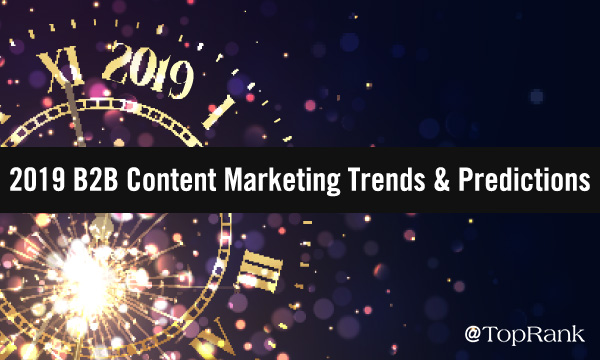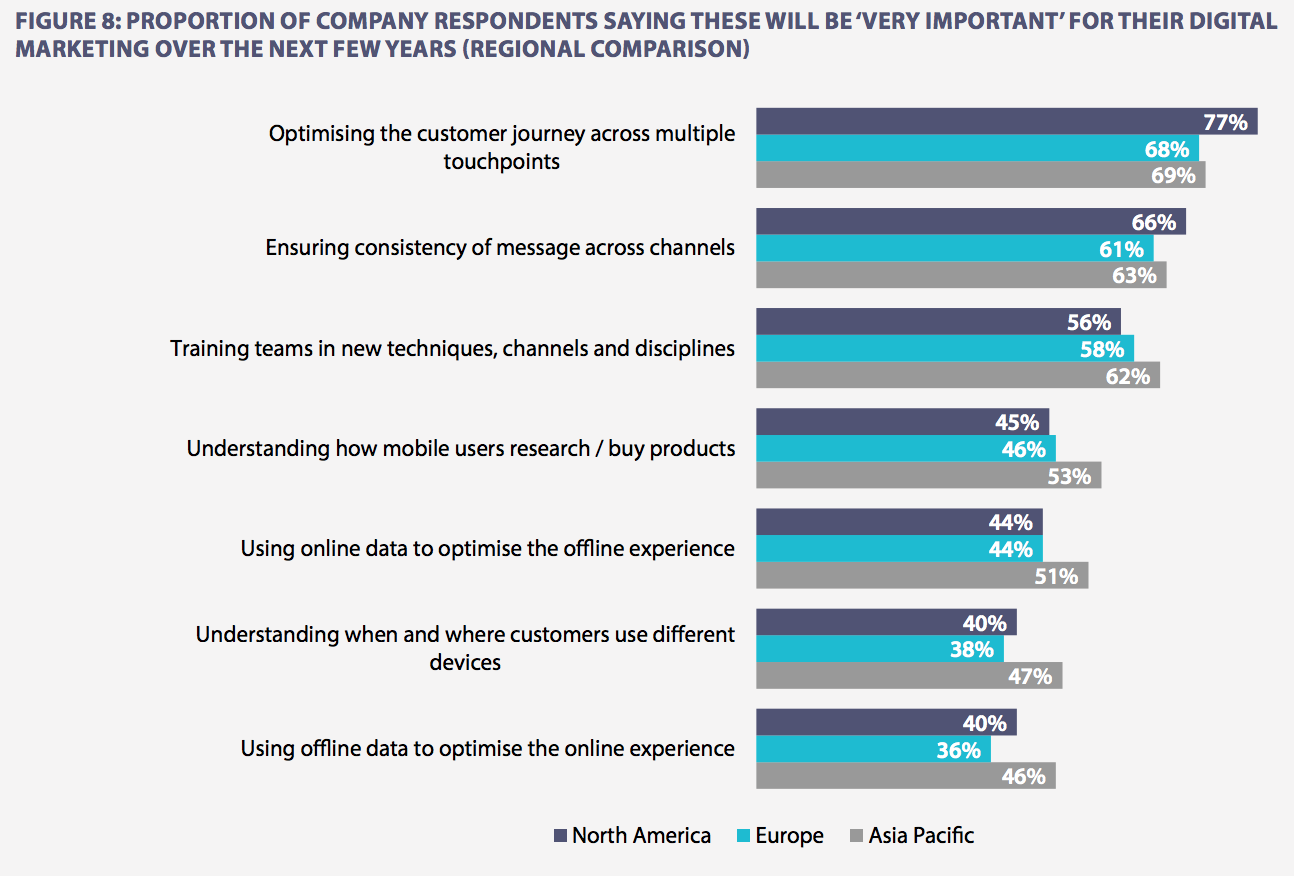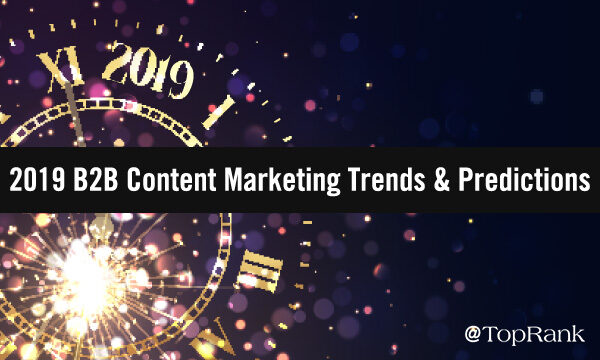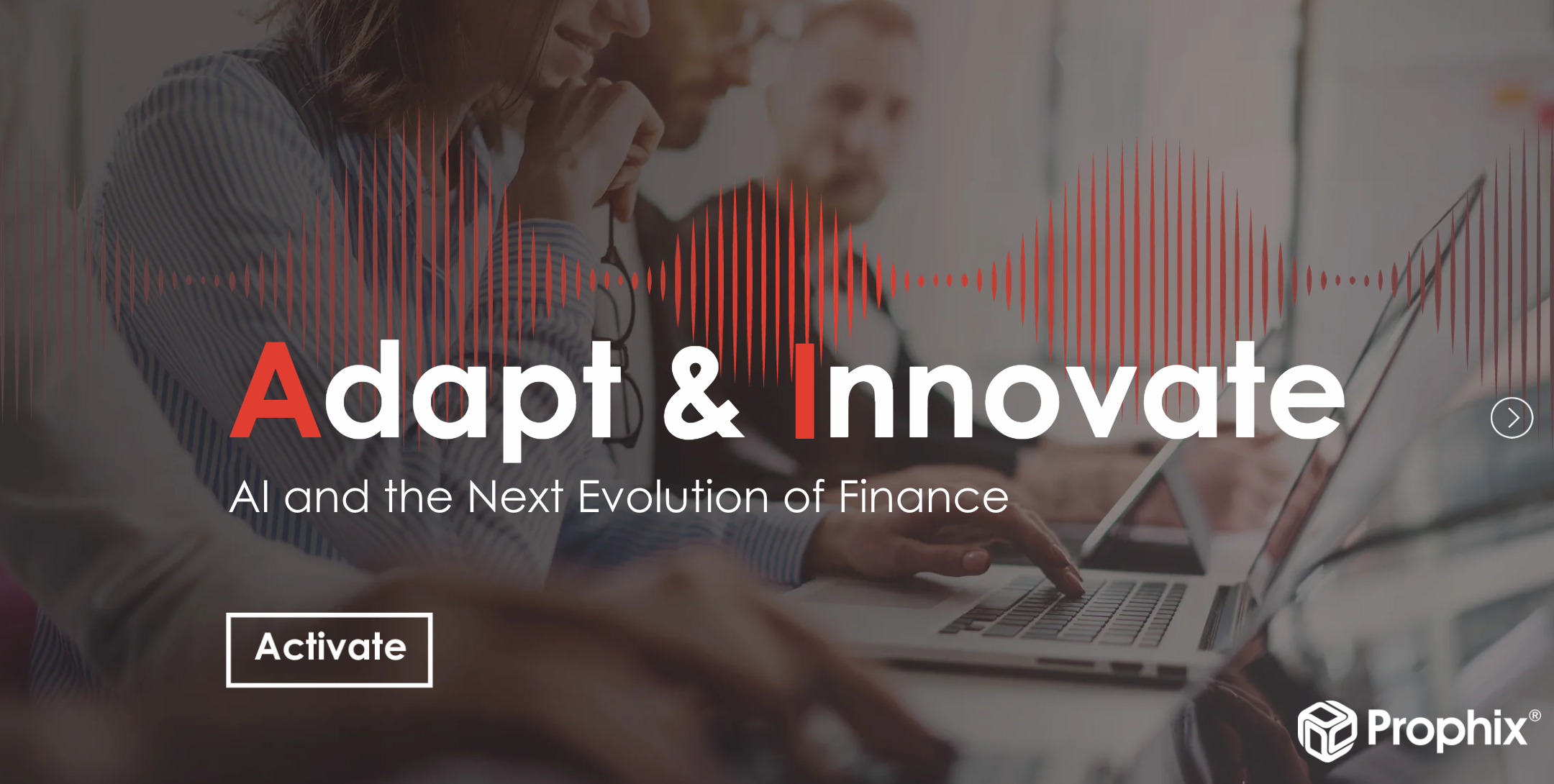
It’s that time of year, B2B marketers. As the holiday seasons kicks into high gear and the countdown to a new year accelerates, we all find ourselves looking into our figurative crystal balls to gauge what the new year will bring, and how we’ll improve ourselves and our content marketing strategies, capitalize on opportunities, and adapt or side-step new challenges as they come.
2018 was a big year for content marketers—from the implementation of new data privacy and security regulations like GDPR to the rise of promising new tools and technologies to enhance personalization, measurement, and data analyzation. And from our perspective, 2019 is on track to bring even bigger changes, presenting both opportunities and challenges for B2B marketers.
So, what does the future hold for content marketing in the B2B space? Here are our top 10 B2B content marketing predictions and trends marketers should know now and keep an eye on into the new year.
#1 – The Trust Factor
From security scandals and privacy concerns to consumers’ dwindling confidence in the world’s core institutions, trust is in crisis. In fact, the last two Edelman Trust Barometer surveys have revealed declining consumer trust toward business, media, and government, and NGOs to “do what is right.” This was the first time a decline was reported since the inception of the report nearly two decades ago.
Couple general distrust with historical skepticism of marketing and advertising messages, and it will be even more imperative for B2B marketers to focus on building trust and credibility with buyers and prospects.
This means doubling down on marketing with authenticity to create more meaningful audience connections will be critical going forward.
“Fostering a truly authentic reputation in this faceless digital world, while combating the instinctive consumer tendency to distrust corporate messaging, presents a very real challenge,” Nick Nelson, TopRank Marketing Content Strategist, said not too long ago. “Those brands that are ready to meet it with gusto will become champions of the new era.”
Brands that are ready to meet authenticity with gusto will become champions of the new era. - @NickNelsonMN #ContentMarketingTrends #ContentMarketing Click To TweetThis also means striving to be the best answer for your audience, delivering quality, relevant content that informs, educates, and inspires. This means leveraging the right data, at the right time, for the right purpose to show audiences they can trust your brand.
“Great content answers questions and solves problems for your customers,” Amanda Todorovich, Senior Director of Content & Creative Services, Cleveland Clinic, told us. “When you do that—no matter what platform or format—it works and generates engagement every time.”
Finally, this also means taking the initiative to align yourself with credible, relevant voices (e.g. influencers) and collaborate on creating incredible, insightful, trustworthy content. (We’ll get into more detail on that later.)
Now for the curve ball.
In 2019 and beyond, building trust cannot be limited to your prospects and customers. Building trust also has to happen within the organization—especially at the C-suite level.
A study from Fournaise Group found that 73% of CEOs say marketers lack business credibility and the ability to generate sufficient growth. Furthermore, 80% of CEOs simply don’t trust marketers at all, yet a whopping 91% do trust CIOs and CFOs.
“Marketing done well with a clear why, measurement and purpose creates the kind of value that both customers and business leaders will trust, ensuring credibility and investment far into the future,” our CEO Lee Odden wrote earlier this year.
#2 – Goodbye “Consumable” Content; Hello Personalized Experiences
In 2018, talk of “content personalization” and “creating content experiences” has been growing louder. And in 2019, it’ll likely hit a fever pitch.
Econsultancy and Adobe’s 2018 Digital Trends report revealed that delivering personalized experiences in real-time is the most exciting opportunity for digital and marketing professionals. Furthermore, optimizing customer experiences across multiple touchpoints is a top priority over the next few years.

This means that in 2019 and beyond, B2B marketers have to stop thinking about how audiences “consume” content, and start thinking about how audiences want to experience content and how they can deliver.
More than likely, to deliver tailored experience you’ll need to embrace proven and emerging marketing technologies such as those driven by AI and machine learning that can help enable personalization and enhance experiences.
In addition, this will require you to align different stakeholders/departments across the organization.
“First and foremost, personalization is a group effort which cuts across all functions of the content supply chain: strategy, planning, creation, assembly, and delivery,” Peter Krmpotic, Group Product Manager at Adobe, told us in an interview. “Establishing and aligning these functions with each other is the first block in a strong foundation.”
Personalization is a group effort which cuts across all functions of the content supply chain: strategy, planning, creation, assembly, and delivery. @PeterKrmpotic #ContentMarketing Click To TweetFinally, it’s seems as if “disposable” content fits in here, too. Instagram Stories. Facebook Stories. Snapchat Stories. These tactics are part of the experience you can create, offering an in-the-moment conversation or touchpoint with your audience.
“When it comes to social media content, B2B marketers need to go beyond links to their blog posts,” Joshua Nite, Senior Content Marketing Manager at TopRank Marketing, shared. “Think about Stories on Facebook, Instagram & Snapchat, for example. It’s about an ongoing conversation with your audience.”
#3 – The Breakdown of Data Silos
Every marketer has data–some may even say they need or want more of it. However, access to so much data is still relatively new, and every marketer wishes they had the ability to draw more insights that lead to action. And being able to draw that insight is critical to success.
“The success of your content marketing efforts hinges on your ability to empathize and connect with your target audiences,” Annie Leuman, Content Strategist at TopRank Marketing, said. “As a result, you absolutely want to use data insights to develop a more holistic picture of your target buyers—their interests, problems, behaviors, and preferences. Taking the time to do this can help you ensure your strategy is built on data, not gut feel or assumptions.
Thankfully, rising and more established marketing technologies have the potential to make a big impact in that area in 2019 and beyond.
In April 2018, more than 6,800 marketing technology solutions were on the market, which was a 27% growth from the year before. And you can bet the number of solutions did and will continue to grow, and sophistication and refinement will happen as well.
It’s my prediction that forward-thinking brands and marketers will stop being satisfied with using only a fraction of the data they have. The hungriest marketers will be prioritizing their data and insight needs, and paying attention to and seeking out technology or partners that can help.
The hungriest marketers will be prioritizing their data and insight needs, and paying attention to and seeking out technology or partners that can help. @CaitlinMBurgess #ContentMarketingTrends Click To Tweet#4 – The Evolution of Content Marketing Sophistication
Content marketing is no longer a shiny object—it’s a core strategy and tactic for most B2B marketers. Content marketing is simply “marketing” in the modern digital era. In fact, in this year’s B2B Content Marketing 2019: Benchmarks, Budgets, and Trends—North America from Content Marketing Institute (CMI) and MarketingProfs, the percentage of marketers engaging in content marketing wasn’t called out in the opening slides. Instead, key insights centered on success drivers, tactical mixes, and so on.
To me, this signals that B2B content marketers are intimately aware that content marketing is a viable strategy and they’re committed. And that means more will be committed to growing their sophistication in 2019 and beyond.
However, marketers need to be aware that growing sophistication is rooted in “mastering simplicity.” Every content marketer wants to level-up their content marketing skills and results, but some may not have mastered the basics yet, like committing to a documented content marketing strategy, setting measurable goals, and putting a process in place for measuring and analyzing performance.
The CMI and MarketingProfs report makes one thing clear: As organizations grow in their content marketing maturity (i.e. drive sophistication), success grows, too.
In 2019, B2B marketers who want to grow will need to do a gut check to ensure they have “the basics” locked down. And then, you’ll need to set measurable goals—goals that align with your overall objectives—for how you’ll grow content marketing maturity.
#ContentMarketing is no longer a shiny object—it’s a core strategy and tactic for most #B2B marketers. @CaitlinMBurgess Click To Tweet#5 – Mastering “Always-On” Promotion Will Further Enable Content Marketing Success
Marketers know that promotion and amplification is the culmination of all their other marketing efforts. But many haven’t adjusted their strategies to account for declining organic visibility, the rise of answer boxes in search, the increasing demand for more visual, engaging, and experiential content, and more.
Essentially, we all know the digital landscape and the types of content that are in demand have changed—and they’ll continue to evolve. That means how we promote content needs to change. And in some ways, that means going back to basics.
For TopRank Marketing, this means renewing (or beginning) a commitment to always-on promotion in 2019 and beyond. An email nurture and a few social posts simply can’t give your content the exposure it needs.
“Today’s world of information overload and the multitude of device options for consuming information makes standing out even more challenging,” Lee said recently. “Content promotion can’t be effective if it’s an afterthought.”
Today’s world of information overload and the multitude of device options for consuming information makes standing out even more challenging. #ContentPromotion can’t be effective if it’s an afterthought. @leeodden #ContentMarketing Click To TweetRead: 50 Content Promotion Tactics to Help Your Great Content Get Amazing Exposure
#6 – The Expansion of What’s Considered “Content”
Text. Images. Video. Audio. These are arguably the core content “categories” most B2B marketers are comfortable with. But, if they haven’t already, B2B marketers will have to look beyond these forms in 2019 and consider the role of content in emerging technologies. Namely, content that is delivered through IoT devices such as smart watches, cars, appliances, bots, and smart speakers.
While IoT devices are largely looked at under the consumer lens, consider these statistics for a moment:
- 51% of the world’s top marketers say that they believe IoT will revolutionize the marketing landscape by 2020. (Source: Marketo)
- 127 new devices connect to the internet every single second. (Source: McKinsey)
- A whopping 75 billion devices are expected to be connected by the year 2025. (Source: Statista)
This means there’s an opportunity for all marketers to build data-driven relationships with customers in real-time, allowing you to tailor content to enhance experiences, resolve unreported problems, and create targeted offers based on behavior.
#7 – Democratized Content Creation Is Growing
For years, Lee has said: “Everyone is influential about something.” In 2019 and beyond, we’ll see this come to more vivid life.
With ubiquitous internet connectivity and a myriad of devices, everyone is empowered to publish and attract like-minded networks. For B2B marketers, this means developing networks of expert and/or influential collaborators to create content with for maximum impact.
“Influencer generated content has evolved past working with celebrities and brandividuals to engaging micro-influencers and nano-influencers, which are essentially all of us,” Lee notes. “Brands that create smart networks of collaborators will be not only scale the quantity of quality content they can create, but involve the very audience they’re marketing to in its creation.”
Brands that create smart networks of collaborators will be not only scale the quantity of quality content they can create, but involve the very audience they’re marketing to in its creation. @leeodden #ContentMarketing Click To Tweet#8 – The Undeniable Rise of Interactive
As I previously mentioned, the bar for content experiences was raised in 2018 with an increase in interactive and experiential content. Why? It’s no longer enough to inform buyers. Instead, you must provide story-driven content that connects on intellectual and emotional levels.
As consumer expectations (remember consumers are your buyers) increase, brands will need to invest in content quality and experience. From producing episodic content with production values near those seen in traditional media to interactive content that works across channels.
When it comes to interactive content, we’re not just talking about quizzes and polls. We’re talking about hyper-relevant, immersive, visual experiences that pull people in and allow them self-guide the journey. If you’re not convinced yet, the statistics speak for themselves:
According to the Content Marketing Institute (CMI) and Ion Interactive 2017 Interactive Content Study:
- 87% of marketers agree that interactive content grabs the attention of the reader more effectively than static content.
- 77% of marketers agree that interactive content has reusable value, resulting in repeat visitors and multiple exposures.
- 73% of marketers agree that interactive content, when combined with other more traditional content marketing tactics, enhances message retention among their audiences.
Furthermore, we’ve seen it in action. Take a peek at this interactive piece centered on AI in Finance from our client, Prophix.
You could get the same information across in a static eBook, of course. But this provides an experience—and results. Within the first 90 days after launch, we saw a 642% increase in asset engagement and a 10% conversion rate to the asset.
Read: Interactive Content Marketing: Why B2B Marketers Should Take Their Content from Boring to Bold
#9 – The Continued Rise of Influencer Integration
Influencer marketing has long been seen as a stand-alone promotion or PR function. But we believe that view is changing as more B2B brands dip their toe in the influencer marketing waters.
But the biggest trend and opportunity in 2019 will be investing your influencer efforts in content collaborations.
“As brands mature their approach to working with influencers from transactional campaign based engagements to ongoing relationships, the opportunities for influencer collaboration will expand beyond the marketing and PR departments to any department in an organization that produces public-facing content,” Lee said.
He added: “Content is both the vehicle to develop influencer relationships and an output as a result of those relationships. Influencer integration with content marketing will become a characteristic of successful marketers in 2019 and beyond.”
#Influencer integration with content marketing will become a characteristic of successful marketers in 2019 and beyond. @leeodden #ContentMarketingTrends Click To Tweet#10 – Demystified Content Marketing Measurement
According to the aforementioned CMI and MarketingProfs benchmarking study, a top challenge for marketers is measuring the performance of content. And this will undoubtedly continue to be a challenge in 2019 and beyond. But that doesn’t mean you can’t overcome barriers.
As with any type of measurement, it’ll important for you to determine what your metaphorical ruler will be. The success metrics of an individual piece of content will be different from your content ecosystem as a whole.
“The way you measure the success of a blog post, for example, will be different than your metrics for an eBook or product page,” Tiffani Allen, Senior Account Manager at TopRank Marketing said. “Start with your overall goals, then determine how each piece of content fits into those goals, and how you will measure progress.”
And as more B2B brands begin to document or refine their content marketing strategies and the associated metrics, even more headway will be made towards utilization of the analytics capabilities of content marketing platforms and analytics tools.
“This will allow marketers to go beyond the traditional analytics measures of pageviews, bounce rate and time-on-page,” Tiffani said. “For example, you can employ techniques like heat mapping to determine if there are particular areas of interest, conversion or drop-off within your visitors. Or, integrate your CRM data with your analytics data to track movement of prospects through the funnel.”
In 2019, more #B2B marketers will be have the strategy in place to go beyond traditional analytics, integrating techniques like heat mapping or #CRM integration to track movement of prospects through the funnel. - @Tiffani_Allen… Click To TweetReady. Set. Bring it, 2019.
The digital landscape is in constant flux. And the form content takes and how it’s delivered is changing. But one thing that will never change is the importance of quality, insightful, and relevant content for informing, engaging, and inspiring your buying audience.
“Put your customer first,” Carla Johnson, President of Type A Communications, told us earlier this year. “Creating content that delivers value to them will always align your time, talent and resources with what delivers the best ROI.”
What’s your content marketing prediction or trend to watch into 2019? Tell us in the comments section below.




